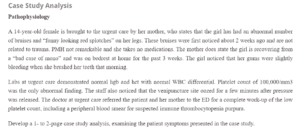Case Study Analysis
The teenage girl’s case is about assessing and evaluating the factors affecting fertility, specifically STD/PID. Risk factors for fertility are those situations that expose females to causal agents of STD/PID (Mark et al., 2019). For example, the red splotches “funny looking” red splotches would be a risk factor for PID/STD. Some of the possible suspects include Chlamydia trachomatis and, perhaps, gonorrhea infections (Store & Greeneville, 2016). It is necessary to ensure prompt treatment of STDs, failure to which a woman (more so young teenage girls) can develop PID and cause irreversible damage to reproductive organs, ectopic pregnancy, and infertility (Mark et al., 2019). Specifically, fallopian tube scarring is one of the major causes of infertility. Therefore, this is a preventable cause when PID is treated early enough, as with the 14-year-old in the case study.
From the historical diagnosis, the girl has had heavy bleeding or a ‘bad case of mono’ and has been recovering or on bed rest for three weeks. Her condition is linked to low platelet count, when menstrual bleeding is heavier and abnormal, lasting longer and occurring between periods (Haamid, Sass & Dietrich, 2017). This shows the risk factors for STD/PID and a possible rising case of infertility. In the case, the symptoms are common with low progesterone times, whereby the cervical mucosal barrier becomes thin, rising at the end of menses towards the early menstrual cycle or period (Mark et al., 2019). All of these symptoms align with the presented case situation. For instance, the girl had been put in bed for the past three weeks (indicating heavy bleeding during menses), and the symptoms (splotches and red skin rashes) appeared in the past two weeks (towards the end of the menstrual cycle).
A concern for the patient is the low platelet count because the standard range is 150,000/mm3 as a minimum and 400,000/mm3 as the maximum, yet hers was lower by 100,000/mm3 (Chetak, Hiremath, Sujay & Dinesh Kumar, 2018). This is a sign that the girl is at risk of bleeding. Due to low platelets in the blood, the Lab report confirms the bruising on the skin, funny red splotches on the skin, and bleeding gums when brushing teeth in the morning. Furthermore, these results confirm the oozing from the venipuncture site after releasing pressure. The doctor’s recommendations for a peripheral blood smear to test for possible suspected immune thrombocytopenic purpura further ascertains her medical condition. The young girl, therefore, has a blood disorder in which her immune system is destroying the body’s platelets and exposing her to pathogens like chlamydia or gonorrhea bacteria since the bleeding cannot stop.
References
Chetak, K. B., Hiremath, V., Sujay, K. R., & Dinesh Kumar, U. S. (2018). Congenital Hypofibrinogenemia detected during preoperative workup for major cardiac surgery. Iranian Journal of Blood and Cancer, 10(3), 96-98.
Haamid, F., Sass, A. E., & Dietrich, J. E. (2017). Heavy menstrual bleeding in adolescents. Journal of pediatric and adolescent gynecology, 30(3), 335-340.
Mark, K. S., Brotman, R. M., Martinez-Greiwe, S., Terplan, M., Bavoil, P., & Ravel, J. (2019). Chlamydia in adolescent/adult reproductive management trial study (CHARM): Clinical core protocol. Contemporary clinical trials communications, 16, 100414.
Store, G. C. D., & Greeneville, T. (2016). Pelvic inflammatory disease: Strategies for treatment and prevention. US Pharm, 41(9), 38-41.
ORDER A PLAGIARISM-FREE PAPER HERE
We’ll write everything from scratch
Question 
Case Study Analysis
Pathophysiology
A 14-year-old female is brought to the urgent care by her mother, who states that the girl has had an abnormal number of bruises and “funny looking red splotches” on her legs. These bruises were first noticed about 2 weeks ago and are not related to trauma. PMH not remarkable and she takes no medications.

Case Study Analysis
The mother does state the girl is recovering from a “bad case of mono” and was on bedrest at home for the past 3 weeks. The girl noticed that her gums were slightly bleeding when she brushed her teeth that morning.
Labs at urgent care demonstrated normal hgb and hct with normal WBC differential. Platelet count of 100,000/mm3 was the only abnormal finding. The staff also noticed that the venipuncture site oozed for a few minutes after pressure was released. The doctor at urgent care referred the patient and her mother to the ED for a complete work-up of the low platelet count, including a peripheral blood smear for suspected immune thrombocytopenia purpura.
Develop a 1- to 2-page case study analysis, examining the patient symptoms presented in the case study.
